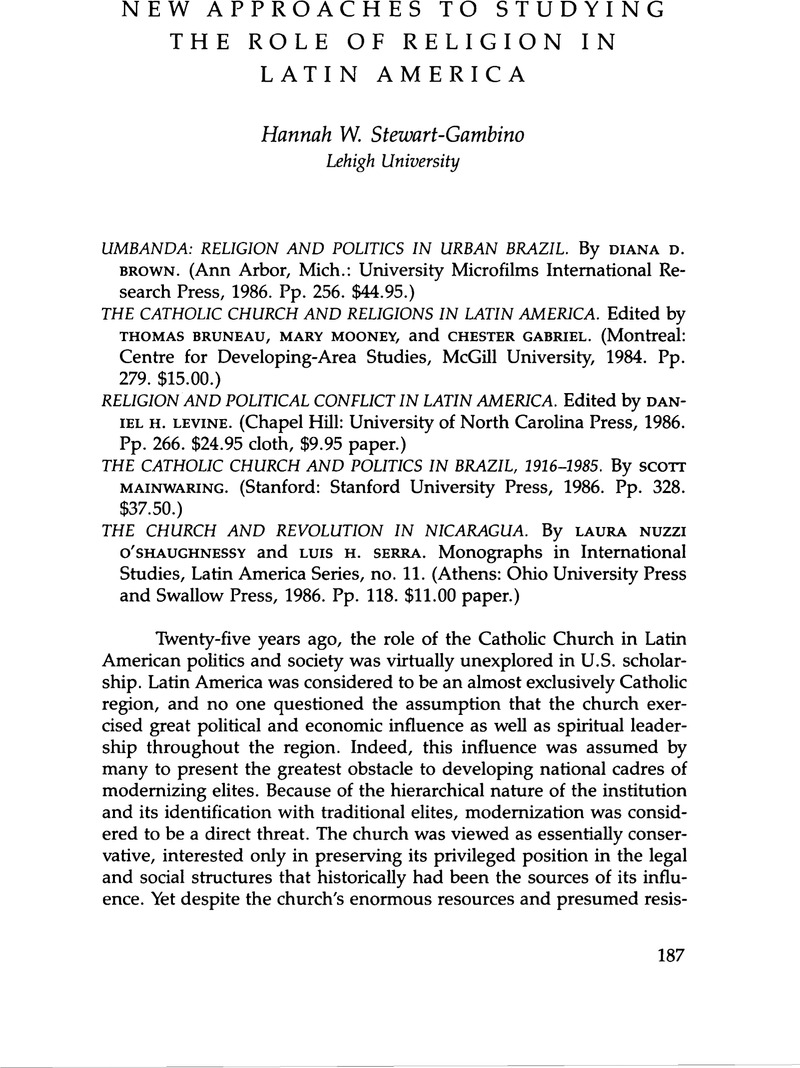No CrossRef data available.
Article contents
New Approaches to Studying the Role of Religion in Latin America
Review products
Published online by Cambridge University Press: 12 October 2022
Abstract

- Type
- Review Essays
- Information
- Copyright
- Copyright © 1989 by the University of Texas Press
References
Notes
1. See, for example, Puebla and Beyond, edited by John Eagleson and Phillip Scharper (Maryknoll, N.Y.: Orbis, 1980); Theology in the Americas, edited by Sergio Torres and John Eagleson (Maryknoll, N.Y.: Orbis, 1976); and Churches and Politics in Latin America, edited by Daniel Levine (Beverly Hills, Calif.: Sage, 1980).
2. For the best recent look at the progressive movement in the Latin American church, see The Progressive Church in Latin America, edited by Scott Mainwaring and Alexander Wilde (Notre Dame: University of Notre Dame Press, 1989).
3. For other works that discuss this relationship, see Michael Dodson and Tommie Sue Montgomery, “The Churches in the Nicaraguan Revolution,” in Nicaragua in Revolution, edited by Thomas W. Walker (New York: Praeger, 1982), 161–80; Phillip Berryman, The Religious Roots of Rebellion: Christians in the Central American Revolutions (Maryknoll, N.Y.: Orbis, 1984); and Margaret E. Crahan, The Church and Revolution: Cuba and Nicaragua (Bundoorah, Australia: Institute of Latin American Studies, La Trobe University, 1988).
4. See Thomas Bruneau, The Church in Brazil: The Politics of Brazil (Austin: University of Texas Press, 1982); Thomas Bruneau, “Church and Politics in Brazil: The Genesis of Change,” Journal of Latin American Studies 17, pt. 2 (Nov. 1985); Scott Mainwaring, The Catholic Church and Politics in Brazil, 1916–1985 (Stanford, Calif.: Stanford University Press, 1986); Scott Mainwaring, “The Catholic Church, Popular Education, and Political Change in Brazil,” Journal of Inter-American Studies and World Affairs 26 (Feb. 1984):97–124; and Scott Mainwaring and Eduardo Viola, “New Social Movements, Political Culture, and Democracy: Brazil and Argentina in the 1980's,” Telos 61 (Fall 1984):17–52.
5. See Brian Smith, The Church and Politics in Chile: Challenges to Modern Catholicism (Princeton: Princeton University Press, 1982).
6. In addition to Bruneau's The Church in Brazil: The Politics of Religion, see Thomas Bruneau and W. E. Hewitt, “Patterns of Church Influence in Brazil,” paper presented at the meetings of the Latin American Studies Association in New Orleans, 17–19 Mar. 1988.
7. Cornelia Butler Flora, Pentecostalism in Colombia: Baptism by Fire and Spirit (Rutherford, N.J.: Fairleigh Dickinson University Press, 1976).
8. The most visible proponent of this view in the Vatican is Cardinal Joseph Ratzinger, prefect of the Sacred Congregation for the Doctrine of the Faith. For an excellent study of the theological underpinnings of Ratzinger's thought, see Aidan Nichols, The Theology of Joseph Ratzinger (Edinburgh, Scotland: T. and T. Clark, 1988).
9. A good example of this explanation is Carmen Galilea, Los Pentecostales y la Iglesia Católica hoy día en Chile (Santiago: Centro Bellarmino, 1984).


